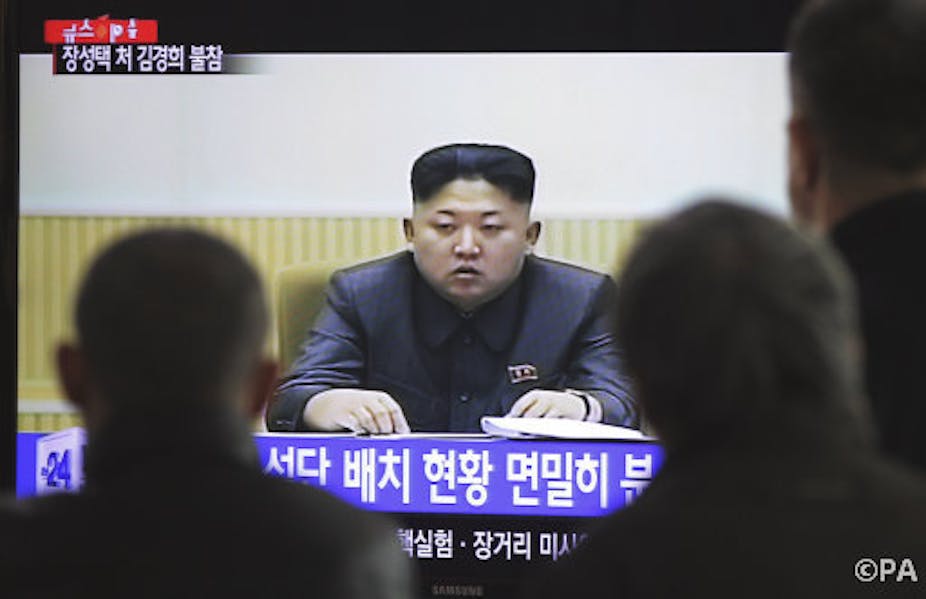The controversial visit to North Korea by Dennis Rodman has provoked much comment, most of it critical of the former NBA basketball player for lending the gloss of his stardom to a brutal dictatorship. Rodman has referred warmly to his friendship with Kim Jong-Un, with whom he has been photographed laughing and joking. In what The Daily Telegraph called his “Marilyn Monroe moment”, he burst into an impromptu rendition of “Happy Birthday” for the North Korean leader prior to a basketball match between the visitors and a local team.
There is much to be said about the strange capacity of dictatorships to attract endorsements of one sort or another from naïve foreigners. But it is worth asking what it is that North Korea hopes to gain from Rodman’s visits (the current one is the fourth in around a year) and their ensuing publicity. More broadly, we might ask what it is that draws dictators to sportsmen, entertainers, and the razzamatazz of showbusiness.
Dictators generally embrace sport, even if they do not always themselves pose as sportsmen. Sport provides a way of forming youth, instilling national pride, occupying dangerous idle time, and creating tame national idols. International competition may offer opportunities to assert national primacy, or simply to convey a sense of normality that might otherwise be difficult to achieve. In particular, sport and showbusiness are now so intertwined that foreign sports stars like the much-tattooed showman Rodman can immediately lend glamour and glitz to events, places and – if they so choose – regimes.
By joking and joshing with Rodman, Kim gives the impression that he has a lighter side, and that he just happens also to be the leader of a brutal regime. Publicity like this must be particularly welcome after the rumours – widely distributed on the internet but since scotched – that Kim’s disgraced uncle and several of his collaborators were executed by being fed live to a pack of starved dogs.
Kim, in any case, is not averse to jovial imagery. With his chubby cheeks and comic haircut, he looks as though he likes a good time, and this has been deliberately cultivated by his regime. Official photographs often show him smiling, with a group of subservient officials standing some distance from him. In this, he differs little from his grandfather Kim Il-Sung, to whom he bears a clear resemblance. The many portraits of the latter which still adorn public places in the country feature him beaming broadly, his parted lips revealing a set of sparkling white teeth.
Dictators generally smile for two reasons: when they want to be liked (knowing that there are good reasons why they might not be) and when they want to convey a sense of generalised satisfaction. Smiles, in this sense, are propaganda. But they also are linked to the diffusion of smiles that accompanied the rise of mass culture. The Hollywood smile, which is usually assumed to have begun with Douglas Fairbanks before being feminised by Rita Hayworth, was described in the 1950s by Edgar Morin as halfway between a laugh and a smile; it was a contagious, euphoric expression of joy which transmitted optimism and well-being. As the first showman-dictator, Benito Mussolini almost never smiled in the 1920s – but by the late 1930s, as his popularity began to dip, he was pictured smiling much more frequently.
Glamocracy
Glamour has been annexed in various ways by dictatorships. The German critic Siegfried Kracauer was the first to note that the orchestrated mass rallies loved by the Nazis bore some relationship to the choreographed bodies that figured in Busby Berkeley’s musicals. “Mass ornaments” provided a particular enchantment that suited both Fordist America and fascism. Many dictators, including Mussolini, Hitler and Kim Jong-Il were often great consumers of movies, and their public images were modelled in part on film stars. Unlike western democratic leaders in the mid-20th century, many of whom had little familiarity with popular culture, they understood mass aesthetics. Stalin, of all people, was played on screen in his lifetime by the lookalike Mikheil Gelovani.
Of the constituent elements of glamour, beauty and theatricality fit more easily with dictatorship than fashion, sex appeal and consumption. What can never be taken over is the sense of individual potential for transformation and realisation that glamour typically offers. Under dictatorships, this is either sublimated within collective activities or repressed. In dictators’ private spheres, however, things may be different.
Dictators have cultivated the most varied of tastes, although the relative austerity of the inter-war leaders would seem in more recent decades to have been replaced by ghastly excess. On the basis of evidence gathered following the downfalls of Saddam Hussein and Muammar Gaddafi, dictator chic nowadays is a combination of old-style Beverly Hills and the décor of Brian De Palma’s 1983 gangster film Scarface.
The 31-year old, Swiss-educated Kim Jong-Un is probably less attracted to glamour than the dictators of past generations. Via inevitable engagements with youth culture, he may have a keener interest in some idea of cool; indeed, his affinity for Rodman may well be informed by a misplaced idea that the African-American basketball player is the epitome of rebellious cool. In fact, Rodman’s well-known penchant for hyperbolic behaviour and wacky personal adornment owes less to cool than to kitsch. It is entirely likely that, in the private quarters of the North Korean elite, he will have found no shortage of examples of that.

